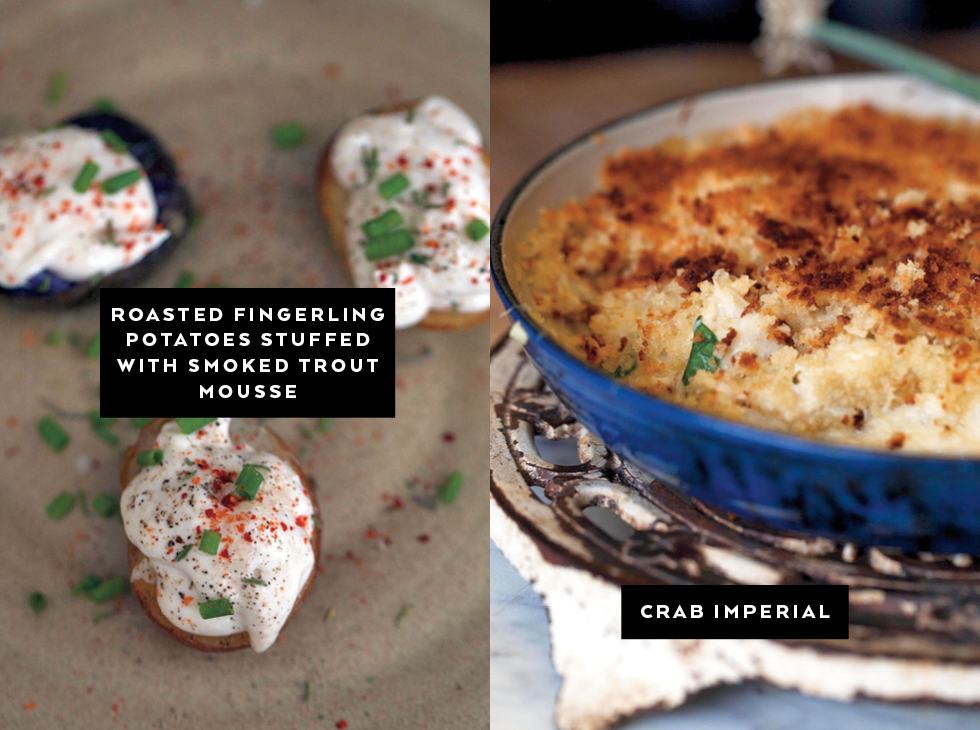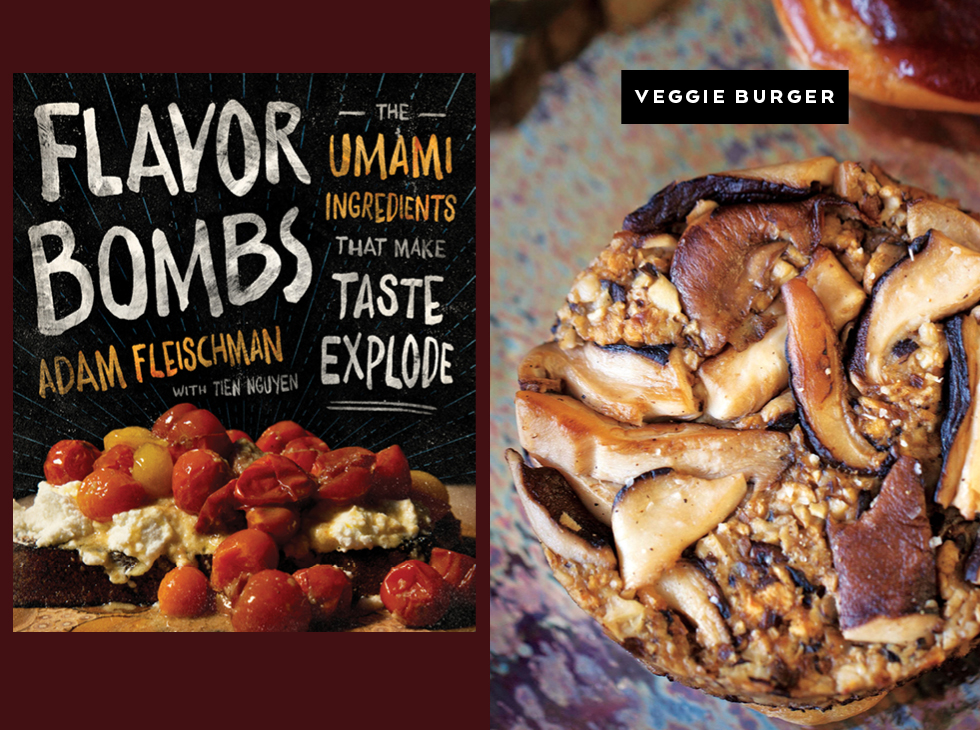Founder of Umami Burger, Adam Fleischman takes the elements of umami and creates combinations that will have your taste buds dancing in his new cookbook. The meaty leanings of umami carry through many foods: tomatoes, mushrooms, parmesan cheese, asparagus, and much more. Fleischman loves to stack these foods together for extra spectacular results.
It all started with his analysis of the typical American burger, one with melted cheese, caramelized onions, tomatoes, and ketchup. All those ingredients are umami-based, and together really add up to much more than a sum of their parts. Same idea with pizza—tomato sauce plus melted mozzarella cheese plus mushrooms plus sausage makes it that much more special. Hence, the Flavor Bombs.

The term “umami” is a Japanese word that roughly translates to “tasty,” or “delicious.” Coined by Dr. Kikunae Ikeda who was amazed by the meat-like flavor in a bowl of dashi. It got him wondering why his soup had a distinctly savory, meaty flavor even though there was no meat in it. He would later link the taste to tomatoes, cheeses, asparagus, and meats.
Fleischman even looks at the chemicals compounds found in many umami which falls into three categories: glutamate, inosinate, guanylate. Each of these groups have a phenomenal tastes on their own, but when combined the flavor amplifies exponentially. Then Fleischman offers up the techniques for amplifying umami: searing, salting, long-cooking, fermenting, and curing in his recipes to create his Flavor Bombs.
The section on stocking your pantry to get even more impact, includes anchovies, duck fat, dried mushrooms, miso, and—are you catching my drift?
To start your umami journey, you might want to try his master recipes that can be used for many purposes. Umami Master Dust can be sprinkled on foods or used as a rub. Umami Master Sauce is perfect for use in extended cooking, like stews or braised meats. Umami Ketchup is guaranteed to wow. There are seven other basic condiments that he has designed to umami-up your cooking gauge, so you will be set.
Please enjoy this recipe for a Veggie Burger from the book, and see if it doesn’t hit the spot.
recipe
Veggie Burger
I use mushrooms as the primary component for my veggie burger and infuse them with miso, a bit of Umami Master Sauce, and egg yolks—all from the Umami Pantry—to bump up the flavor even more.
Because the patties need a few hours to set, prep them the night before and they’ll be ready to go when it’s time to start cooking.
Note: Textured vegetable protein (TVP), also sold as textured soy protein, is available at Whole Foods, health food stores, or online at Amazon.
MAKES 2 BURGERS
UMAMI MASTER SAUCE
MAKES ABOUT 3 CUPS
2 cups top-quality tamari or soy sauce
1/4 cup plus 2 tablespoons sherry wine
1/4 cup dried wild mushrooms, like porcini
1/4 cup red or white miso
1/4 cup honey
1 tablespoon Marmite
1 tablespoon shio koji
Hot sauce
1 (4-by-4-inch) piece dried kombu
—
Start with the tamari or soy sauce, in a pan over medium heat; do not let boil. Add the sherry wine, dried wild mushrooms, and miso. Stir.
Add the honey, Marmite, shio koji, some hot sauce, and the dried kombu. Stir for a minute, remove from the heat, and strain. Add water to taste to dilute its intensity, then cool.
Store, covered, in glass jars for up to around 6 months in your pantry.
—
VEGGIE BURGER
4 dried porcini mushrooms
1/4 cup medium-dry sherry, like amontillado
1 tablespoon white miso
Splash of Umami Master Sauce (see above)
2 large egg yolks
1/2 cup panko bread crumbs or textured vegetable protein (see headnote)
2 tablespoons toasted or regular sesame oil
1 cup stemmed and sliced fresh shiitake mushrooms
Sea salt and freshly ground black pepper
2 potato buns or white hamburger buns, split
unsalted butter
OPTIONAL CONDIMENTS AND TOPPINGS
Mayonnaise
Ketchup
Mustard
Lettuce
Tomato
—
MAKE THE VEGGIE BURGER
Place the dried porcinis, sherry, miso, and master sauce in a small saucepan. Set the heat to medium-low and simmer until the liquid is almost gone, rehydrating the mushrooms, about 10 minutes.
Remove the pan from the heat, cool, then add the egg yolks and panko (or textured vegetable protein). Pulse the mixture in a food processor to incorporate. Set aside.
Heat a large skillet over high heat for a few minutes—you want it to get superhot. Add 1 tablespoon of the sesame oil, wait a minute, then throw in the shiitakes, being careful not to crowd the mushrooms. Season with salt and pepper, and sauté until they’re nicely caramelized, about 6 minutes. Remove the mushrooms to a large bowl and let cool.
When the mushrooms have cooled, add the egg yolk mixture and stir to incorporate. I use a 3-inch ring mold to press out the patties, but if you don’t have a mold, free-form 2 patties with your hands. Be sure to pack the patties fairly tight so they don’t fall apart when you cook them. Refrigerate the patties at least 6 hours or overnight, to set.
You can also place the patties side by side on a baking sheet or dish and stick them in the freezer; when they’re frozen, place the patties in an airtight bag and keep them in the freezer for up to 2 months. Thaw completely before cooking.
When you’re ready to cook, heat a large skillet over medium-high heat with the remaining tablespoon of sesame oil and sauté the patties for 3 minutes on each side. Remove the patties and set aside. Place the Koji-Porcini Resting Sauce or butter in the pan and place the buns cut side down in the pan for a few minutes, just until they’re toasted and warmed through.
Place the patties in the buns and serve with the condiments and toppings of your choice.
Flavor Bombs: The Umami Ingredients That Make Taste Explode by Adam Fleischman
Excerpted from FLAVOR BOMBS © 2018 by Adam Fleischman. Photographs © 2018 by Wendy Sue Lamm. Used by permission of Rux Martin Books/Houghton Mifflin Harcourt. All rights reserved.


